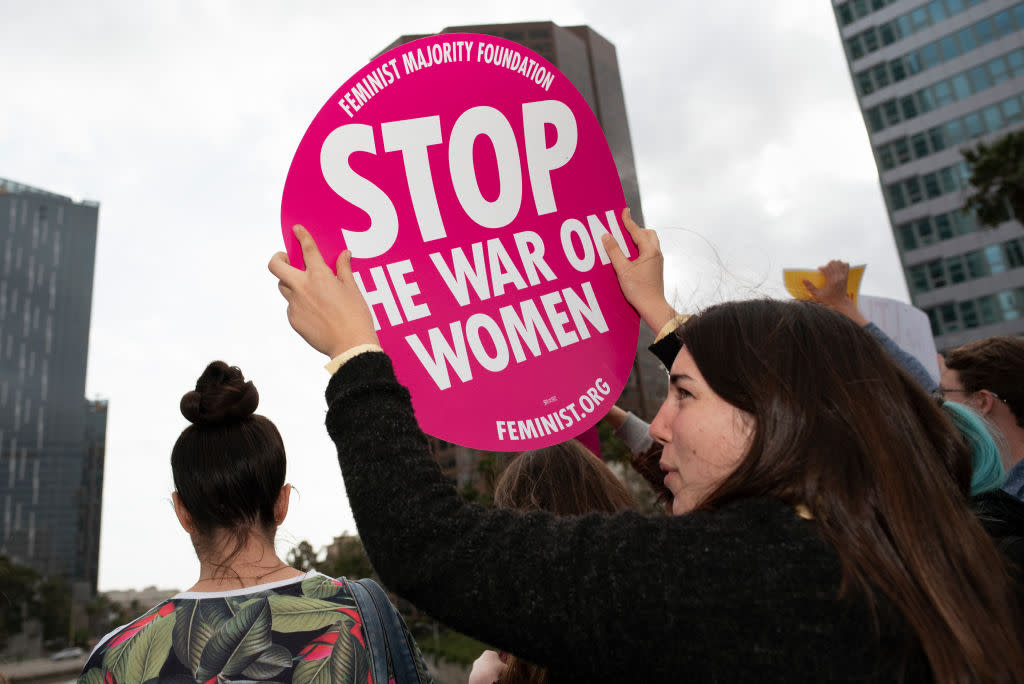The Abortion Fight Isn't a 'War on Women.' It's a War on Poor Women

An activist seen holding a placard that says Stop The War On Women during the protest in Los Angeles in 2019 Credit - Ronen Tivony—SOPA Images/LightRocket via Getty Images
On April 9, Arizona’s supreme court ruled that its 1864 almost total abortion ban remains in place. That came a week after Florida’s supreme court upheld an abortion ban, triggering an even stricter six-week ban. The onslaught of anti-abortion laws and court decisions has led liberals like California Governor Gavin Newsom to assert that the political right has declared “a war on women.”
This concept isn’t new, but it actually distorts the history of anti-abortion legislation. Abortion regulations have never applied equally to all doctors or all women. Understanding this history reveals that today — as in the past — abortion bans affect both women and providers differently depending upon factors like their race, class, and social standing. The people impacted most have changed over time, but one thing has remained consistent: abortion restrictions are less a war on women than a war on poor women.
The conditions that created these class and social dynamics began to emerge almost two centuries ago. In 1829, for example, New York State enacted a law defining abortion as second-degree manslaughter — but only if the woman was “pregnant with a quick child,” that is, if she’d felt the fetus moving inside of her, something that typically happened around 20 weeks.
In the late 1850s, that law — and others like it — came under attack by Boston doctor Horatio R. Storer. In an 1859 essay, he argued that these laws defined the crime of abortion too leniently. “By the Moral Law, THE WILFUL KILLING OF A HUMAN BEING AT ANY STAGE OF ITS EXISTENCE IS MURDER.” He also argued, without evidence, that women could face dire medical consequences from an abortion, including, on occasion, death.
But Storer wasn’t just worried about women as a universal class. He reserved his greatest scorn for white middle- and upper-class women, whom he claimed were seeking abortions in greater numbers than poor and immigrant women. He claimed that middle-class women boasted to each other about their successful abortions, in the same way they might brag about a new dress or a social coup. In Storer’s view, these women who sought abortions were not just victims of a purportedly dangerous medical procedure, but dangerous criminals who were outside the reach of the law.
Read More: What to Know About the Arizona Supreme Court Abortion Ban Ruling
Storer’s anti-abortion activism occurred at a time when he and other “medical men” of similar social standing were attempting to professionalize medicine by implementing rigorous educational and training standards. As part of this push, these doctors hoped to take over what would become the lucrative fields of obstetrics and gynecology from female midwives and other providers they considered untrained and dangerous — those who Storer claimed “frequently cause abortion openly and without disguise.”
In Storer’s view, white, educated “medical men” like him had to seek justice as “the physical guardians of women and their offspring.” It was their responsibility to “stand… in the breach fast making in the public morality, decency, and conscience.” Behind these righteous pronouncements, though, lurked Storer’s unspoken fear: that if men like him did not intervene, middle-class wives would shirk their childbearing duties, leaving their husbands without heirs while poor and immigrant families swelled their ranks.
Storer spent the latter part of the 1850s, and much of the 1860s, organizing letter-writing campaigns by new professional medical societies, including state affiliates of the American Medical Association (AMA). He hoped to pressure states into passing ever-stricter abortion bans. In New York, the effort paid off in 1869 when the legislature made abortion second-degree manslaughter at any stage of pregnancy if it resulted in the death of the mother or the termination of the pregnancy.
In the fall of 1871, the new statute led to the conviction of abortion provider Jacob Rosenzweig for manslaughter in the death of Alice Bowlsby in New York City. Railway officials had found Bowlsby's body in a trunk bound for Chicago only days after the New York Times had published an exposé on abortionists, including Rosenzweig, titled “The Evil of the Age.”
The paper had described Rosenzweig as having a $40 degree, and purportedly knowing “more of the saloon business than of medicine.” Nonetheless, he did “a large business” — part of a “frightful profusion” of discreet abortions performed by untrained practitioners.
It took less than two hours for a jury to find Rosenzweig guilty, and a judge sentenced him to seven years’ hard labor in the Albany State Penitentiary, the maximum sentence possible.
Meanwhile, just weeks after Bowlsby's death, a young Albany waitress named Margaret Campbell died from an abortion performed by “Mrs. Dr. Emma Burleigh,” a well known abortionist. After colleagues of Burleigh’s tried to cover it up — including spiriting Campbell’s body away to an unmarked grave in the local cemetery — a second autopsy revealed that the young woman’s abdomen was inflamed, her uterus was missing, and her breasts were full of milk. A laceration was found in her vagina, “occupied by a clot of blood.”
The outcome for Burleigh, however, was very different than for Rosenzweig. Under cross-examination at the coroner’s inquest, she got the doctors who performed the autopsy to admit that alternate explanations existed for all of their findings. There was no definitive proof that Campbell had been pregnant, that she’d had an abortion, or that the operation had caused her death. The jury agreed that the cause of death was simple peritonitis, and Burleigh walked free.
The disparity between the two cases was no accident. The abortion statute really wasn’t about protecting women from unqualified practitioners, nor was it a war on women, as Storer might have hoped. Instead, it was a weapon of class warfare.
Rosenzweig was a Jewish immigrant — a dangerous outsider. Meanwhile, Burleigh — who lied about having a medical degree in advertisements, but had taken medical classes — was an educated white woman. That made her less of a threat to the native-born doctors like Storer who were working to consolidate medical authority under their own control.
Class also separated the two victims: Newspaper accounts of Bowlsby’s death painted her as a young lady from “respectable society,” with “relatives in the highest circles.” In other words, she was an ideal victim for the villain of the immigrant doctor. Campbell, by contrast, was, in the words of one prominent abortion opponent, an obscure Irish waitress who was “evidently…not of correct moral habits.”
Read More: How Ronald Reagan Helped Abortion Take Over the Republican Agenda
In 1872, New York toughened the law further, defining abortion as a felony with a possible sentence of 20 years in prison. Yet even under this law, wealthy, typically white women continued to seek and receive safe abortions. Often, it was trained male physicians of similar social and class standing who performed them without legal penalties. Strict enforcement of abortion laws didn’t ramp up until the mid-20th century, when medical care moved from private offices exclusive to a well-off clientele into public hospitals and clinics serving the poor along with the wealthy.
Understanding how New York’s abortion laws functioned in the 19th century creates a new perspective on abortion bans in 2024.
They, too, are far more of a weapon of class warfare than a war on all women.
Strict abortion bans are more likely to exist in states where a high number of women of childbearing age have incomes below 200% of the federal poverty line. Of the five states with the highest levels of poverty among women of childbearing age — Mississippi, Arkansas, Louisiana, West Virginia, and New Mexico — all but New Mexico fall into the Guttmacher Institute’s “most restrictive” abortion law category. Poverty strengthens the effects of abortion bans, since poor women can’t afford to miss work, book travel, arrange childcare, and pay out of pocket for procedures if they do not have health insurance.
Abortion bans also exacerbate poverty. A University of California San Francisco study found that women denied an abortion saw an increase in poverty for at least four years and were more likely to see drops in their credit scores. These impacts don’t hurt poor women in isolation: abortion bans also put their children, their husbands, and their wider communities at a disadvantage by making the cycle of poverty harder to escape.

By contrast, just as in the 19th century, wealthier women — those who have health insurance, who can afford a pharmaceutical or surgical copay, and who have the means to take time off work and travel to a state with more lenient regulations — are far more insulated from the most potent and cascading impacts of abortion bans. So, too, are their families and communities.
As in the 19th century, class, hand in hand with race, provides a more useful lens of analysis for understanding abortion legislation in the U.S. In restricting abortion, “medical men” like Storer worked to consolidate medical authority among the white upper classes. Today, it is often men from a similarly high social and class standing, serving in state legislatures and on courts, who are once again pushing for abortion restrictions that most adversely impact Americans with less social and economic capital.
R.E. Fulton is an independent historian of medicine, gender, and crime whose work focuses on abortion practitioners in 19th-century New York. Their book The Abortionist of Howard Street, out May 2024 from Cornell University Press, studies the life and career of Josephine McCarty, alias Emma Burleigh.
Made by History takes readers beyond the headlines with articles written and edited by professional historians. Learn more about Made by History at TIME here. Opinions expressed do not necessarily reflect the views of TIME editors.
Write to Made by History at madebyhistory@time.com.

